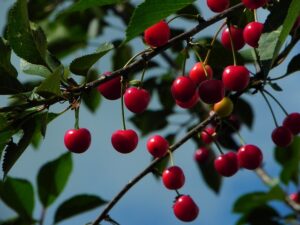Growing your own fruit in a cold climate can be an exhilarating challenge. While the dips in temperature may deter some gardeners, the potential bounty of a well-maintained orchard is more than enough reason to roll up those sleeves and get to work. Zone 4 encompasses regions with a tough climate where temperatures can plummet to -30°F. However, it is entirely possible to Zone 4 fruit trees that not only survive the winter but also provide delicious, home-grown produce come summer. Here, we explore the top choices for hardy fruit trees that are perfectly suited for the chill of Zone 4.
What Makes a Fruit Tree Suitable for Zone 4?
When it comes to fruit trees, hardiness is key. In zone 4, trees need to be able to withstand the cold, not just in terms of temperature resilience but in the manner of their growth, too. Hardy trees can cope with freeze-thaw cycles and reduced daylight hours. They’re often selected for their ability to bear fruit early in the growing season, ensuring a prolonged period of ripening before the next freeze. For aspiring gardeners in Zone 4, it’s all about choosing fruit tree varieties with low chill hours, as well as understanding crucial factors like soil conditions, and the late frost risks in the region.
Best Fruit Trees for Zone 4
Apple Trees
Apples are the quintessential fruit tree, and Zone 4 is home to some stellar varieties. ‘Honeycrisp’, ‘McIntosh’, and ‘Haralson’ are popular choices. When growing apples in Zone 4, prioritizing varieties with a low-temperature chill requirement and late blooming periods can protect them from unexpected spring frost. Full sun exposure, well-drained soil, and proper spacing for air circulation are crucial for their health and robust fruiting.
Pear Trees
Pears are perhaps the most versatile trees in the orchard, with both eating and canning varieties available. In Zone 4, options like ‘Luscious’, ‘Parker’, and ‘Summercrisp’ can thrive with the right care. These trees appreciate full sun and well-drained soil, but consistent watering is what truly brings out their unique texture and flavor.
Plum Trees
Plums come in a wide array of flavors and colors, and several varieties stand up to the conditions of Zone 4. ‘Mount Royal’, ‘Pipestone’, and ‘Superior’ are just a few examples. To ensure a strong, productive tree, adequate sunlight and well-drained soil are a must. Regular pruning helps maintain shape and encourages a bountiful harvest.
Cherry Trees
Zone 4 cherry trees can be divas, but treat them right, and you’ll be rewarded with their delicious, heartwarming fruit. Two top choices, ‘Montmorency’ and ‘North Star,’ are renowned for their versatility in the kitchen. Cherry trees prefer full sun and sandy, well-drained soil. Keeping the tree moist without waterlogging is the delicate balance you’ll need to find.
Care Tips for Zone 4 Fruit Trees
Winter Protection: Be proactive in shielding your trees from harsh weather. Wrapping young trunks, mulching, and even erecting windbreaks can make a significant difference.
Pest and Disease Management: Regular inspection and appropriate treatments are the best defense against common maladies. For pests, learn about dormant sprays and beneficial insects that can create a balance in your orchard.
Fertilization Plan: Understand the nutrient requirements of your trees, and develop a fertilization schedule to support healthy growth and bountiful harvests.
Wild Fruit Trees in Zone 4
While cultivated varieties are excellent choices, the wild trees of Zone 4 offer their own delights.
Wild Crabapple (Malus spp.): Often overlooked, these hardy trees produce small, tart fruits that can be used for cooking or even making jelly.
American Plum (Prunus americana): This native plum tree bears astringent fruits, but can be processed into delectable jellies and preserves.
Juneberry (Amelanchier spp.): With its delicate white blossoms and sweet berries, the Juneberry’s beauty and utility can’t be overstated.
Chokecherry (Prunus virginiana): Much like the American Plum, this tree’s raw fruits are best utilized in jams and pies once processed.
Jujubes: A unique addition to the Zone 4 orchard, jujubes produce small, date-like fruits that are prized for their sweet, nutty flavor when dried.
Wild Blueberries: While traditionally found in warmer regions, certain cultivars of blueberries can indeed withstand Zone 4 winters. Their tastes are as varied as their colors, with some offering sweet, succulent berries and others, tangy and intense flavors.
Elderberries: These huge shrubs or small trees are robust and are known for their immune-boosting fruits that can be employed in a myriad of culinary and medicinal applications.
Harvesting and Uses
Optimal Harvesting Times: Each fruit has its own signs of ripeness. With experience, the color and feel of the fruit can indicate when it’s ready to be picked.
Utilizing Your Harvest: From fresh eating to preserves, pies, and even homemade ciders, the uses of your fruit harvest are as varied as the fruits themselves. Gain inspiration for recipes that highlight the flavors of your particular varieties.
In Conclusion
While navigating the unique challenges of Zone 4 can seem daunting, the rewards of a flourishing fruit orchard are well worth the effort. By selecting the right varieties, understanding their needs, and providing thoughtful care throughout the seasons, you can enjoy the sweetness of your fruits year after year. Remember, the colder the climate, the sweeter the fruit—a testament to your dedication and the trees’ fortitude. Happy gardening!

